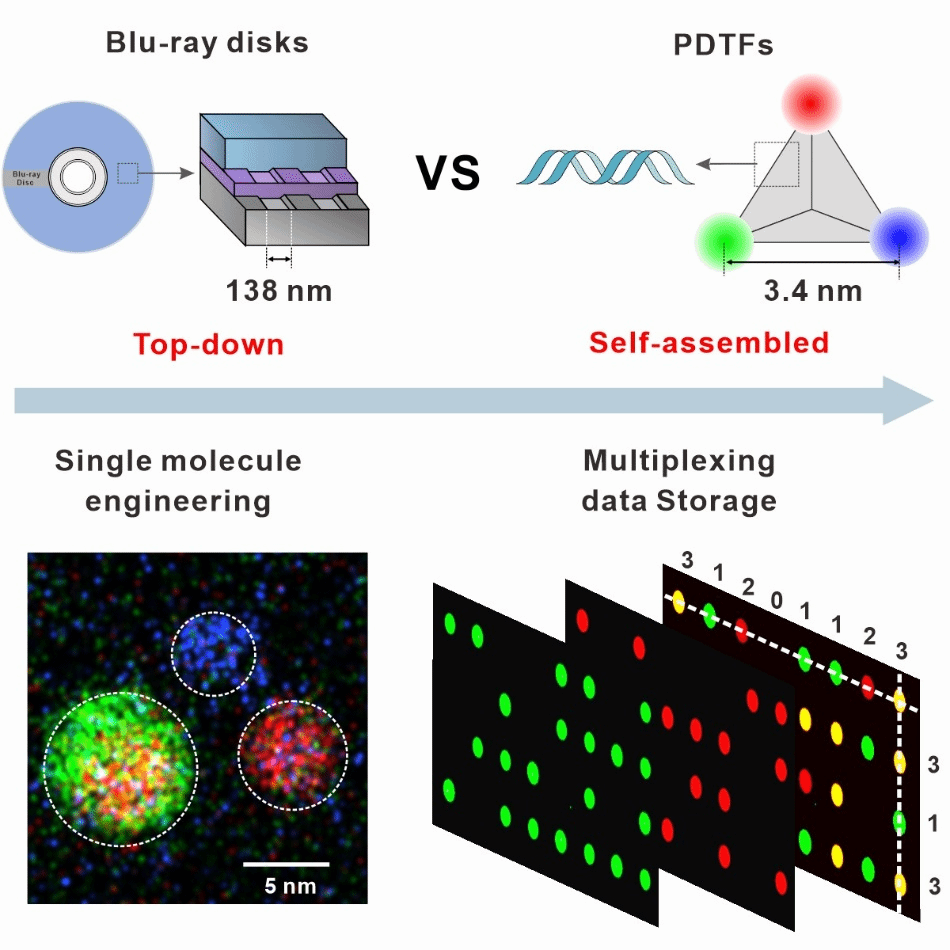搜索


Recently, the research team led by Fan Chunhai (School of Chemistry and Chemical Engineering) and Zuo Xiaolei (Renji Hospital Affiliated to Shanghai Jiao Tong University School of Medicine) from the DNA Storage Research Centre at the Zhangjiang Advanced Research Institute of Shanghai Jiao Tong University published their latest study titled ‘Massively multiplexed optical recording with polychromatic DNA frameworks’ in the journal Matter. This work developed a polychromatic DNA framework nucleic acid (PDTF) based on tetrahedral DNA structures, achieving precise control over its photophysical properties. It demonstrates the immense application potential of DNA framework structures as next-generation big data storage media in the field of massively multiplexed optical storage. Aligned with the national ‘14th Five-Year Plan’ initiative to accelerate development in the frontier field of ‘DNA storage,’ this research lays a technological foundation for massive data storage.
In recent years, global data volumes have experienced explosive growth, with projections indicating worldwide stored data will reach 10²⁴ to 10²⁸ bytes by 2040. An IDC (International Data Corporation) report reveals that from 2018 to 2025, China's data sphere will lead the world with an average annual growth rate of 30%, exceeding the global average by 3 percentage points. By 2025, China's data sphere is projected to expand to 48.6 ZB (1 ZB = 1×10¹² GB), accounting for 27.8% of the global total and becoming the world's largest data sphere. If stored on DVDs (each with a capacity of 4.7 GB), the total length would be sufficient to circle the Earth 62 times. Such colossal data volumes pose significant challenges to contemporary storage technologies (optical discs, hard drives, etc.). Consequently, there is an urgent need to develop next-generation storage technologies suitable for both massive data storage and long-term archiving. Compared to technologies like magnetic tape and hard disks, optical data storage offers higher storage capacity and energy efficiency. However, the feature point size (pit size) and feature point spacing (pitches) of current commercial optical storage devices (such as CDs, DVDs, and Blu-ray discs) have reached their physical limits, hindering further increases in storage capacity.
Optical multiplexing strategies based on single nanoparticles can partially enhance data storage density. However, the precise control of physical properties such as size, shape, surface functional groups, and charge in single nanoparticles is challenging, leading to uncontrollable luminescence characteristics. Consequently, existing nanoparticle-based optical multiplexing technologies cannot generate multidimensional orthogonal data channels to meet the demands of large-scale data storage.
To address these challenges, the research team developed a series of highly programmable multicolour framework nucleic acids (PDTFs), achieving precise control over their optical properties and applying them to large-scale multiplexed optical data storage. In this study, the team leveraged the high programmability of PDTFs to precisely regulate their size from 12.6 nm to 3.4 nm (Figure 1, top) and finely tuned their luminescence characteristics at the single-molecule level. The research encoded 196 (47 million) storage primitives, enabling multiplexed optical data storage (Figure 1, bottom). Concurrently, PDTF demonstrated exceptional erasability-rewritability and stability (estimated via the Arrhenius method to persist for 10,826 years at room temperature), exhibiting significant potential for high-density and long-term data storage applications.

Figure 1: Application of Polychromatic Framework Nucleic Acid (PDTF) in Optical Data Storage
Matter is Cell Press's flagship publication in the materials field, following Chem and Joule, and stands as a sister journal to Cell, Chem, and Joule. The journal welcomes submissions covering fundamental and applied research on outstanding advanced materials across diverse fields, including biomaterials, energy materials, optical materials, and magnetic materials. It aims to advance materials science across multiple disciplines and accelerate the practical development of advanced materials.
Original link: https://doi.org/10.1016/j.matt.2024.10.020






 Address:No.1308 Keyuan Road, Pudong District, Shanghai
Address:No.1308 Keyuan Road, Pudong District, Shanghai Phone:86-21-54740000
Phone:86-21-54740000 E-mail:zias@sjtu.edu.cn
E-mail:zias@sjtu.edu.cn